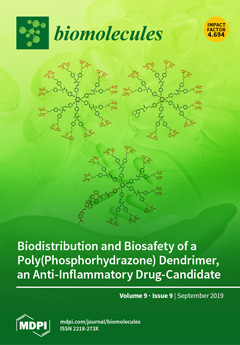The endocannabinoid system represents an integrated neuronal network involved in the control of several organisms’ functions, such as feeding behavior. A series of hybrids of 5-(4-chlorophenyl)-1-(2,4-dichloro-phenyl)-4-methyl-
N-(piperidin-1-yl)-1
H-pyrazole-3-carboxamide (mimonabant), a well-known inverse agonist of the type-1 cannabinoid receptor (CB1), once used
[...] Read more.
The endocannabinoid system represents an integrated neuronal network involved in the control of several organisms’ functions, such as feeding behavior. A series of hybrids of 5-(4-chlorophenyl)-1-(2,4-dichloro-phenyl)-4-methyl-
N-(piperidin-1-yl)-1
H-pyrazole-3-carboxamide (mimonabant), a well-known inverse agonist of the type-1 cannabinoid receptor (CB1), once used as an antiobesity drug, and the
N-(2
S)-substitutes of 1-[(4-fluorophenyl)methyl]indazole-3-carboxamide with 1-amino-3-methyl-1-oxobutane (AB-Fubinaca), 1-amino-3,3-dimethyl-1-oxobutane (ADB-Fubinaca), and 3-methylbutanoate (AMB-Fubinaca), endowed with potent agonistic activity towards cannabinoid receptors CB1 and CB2 were in solution as
C-terminal amides, acids, methyl esters and
N-methyl amides. These compounds have been studied by binding assays to cannabinoid receptors and by functional receptor assays, using rat brain membranes in vitro. The most active among them as an agonist, (S)-1-(2,4-dichlorobenzyl)-
N-(3,3-dimethyl-1-(methylamino)-1-oxobutan-2-yl)-1H-indazole-3-carboxamide (LONI11), and an antagonist, (S)-2-(1-(2,4-dichlorobenzyl)-1H-indazole-3-carboxamido)-3-methylbutanoic acid (LONI4), were tested in vivo in mic, to evaluate their ability to stimulate or suppress feeding behavior after intraperitoneal (i.p.) administration. For a LONI11 formalin test and a tail flick test after an administration by the subcutaneous (s.c.) and intracerebroventricular (i.c.v.) routes, respectively, were also carried out in vivo in mice to investigate the antinociceptive property at the central and peripheral levesl. We observed a significant orexant effect for LONI11 and an intense anorexant effect for (S)-methyl 2-(1-(2,4-dichlorobenzyl)-1H-indazole-3-carboxamido)-3,3-dimethylbutanoate (LONI2) and LONI4. In zymosan-induced edema and hyperalgesia, LONI11 reduced the percent of paw volume increase and paw latency after s.c. administration, also suggesting a possible peripheral anti-inflammatory activity.
Full article






